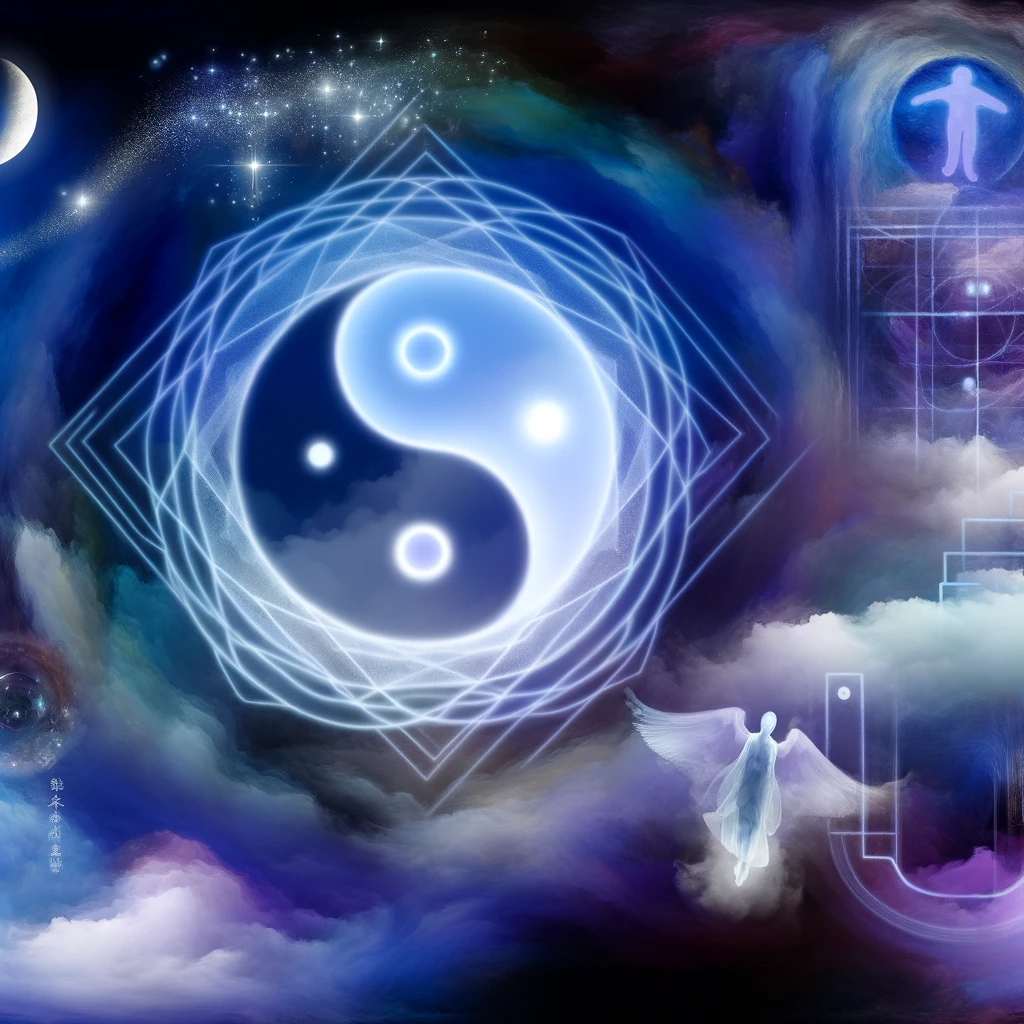The essence of combining lucid dreaming with feng shui is to emphasise the harmony between one’s internal state (inner world) and one’s external environment (outer world). For those interested in personal development, spirituality, and feng shui for environmental harmony, let’s delve into a comprehensive exploration of how these two practices intersect and support each other.
Lucid dreaming, with its ability to foster awareness and control within the dream state, can offer intriguing benefits when integrated into feng shui practice, a discipline concerned with harmonising individuals with their surrounding environment. Although there’s no direct scholarly research connecting lucid dreaming with feng shui, we can extrapolate several potential benefits based on the principles and aims of both practices.
- Enhanced Environmental Sensitivity: Feng shui emphasises the importance of being attuned to the energies and arrangements within one’s living and working spaces. Lucid dreaming can heighten one’s sensitivity to environments, even in the dream state, allowing practitioners to explore and adjust their spatial relationships and energy flows in a subconscious setting. This heightened sensitivity could translate into more intuitive feng shui adjustments in waking life.
- Creative Problem-Solving: Lucid dreaming can serve as a powerful tool for creativity and problem-solving. Feng shui practitioners could use lucid dreams to envision and experiment with different spatial arrangements and design solutions, overcoming practical limitations present in the waking world. This could lead to innovative feng shui insights and applications.
- Personal Development and Harmony: Both lucid dreaming and feng shui aim to improve personal well-being and harmony. Through lucid dreaming, individuals can work on personal growth, face and resolve inner conflicts, and enhance self-awareness. These benefits align with feng shui’s goal of creating harmonious environments that support and reflect one’s internal state. Practitioners might find that lucid dreaming helps them achieve a deeper internal balance, which is crucial for effective feng shui practice.
- Spiritual Insights and Integration: Feng shui is deeply rooted in Taoist philosophy, which values the interconnectedness of all things and the flow of chi (qi), or life force. Lucid dreaming offers a unique state of consciousness that can provide profound spiritual insights and experiences. Practitioners could potentially use lucid dreaming to explore and understand the deeper spiritual aspects of feng shui, enhancing their practice with a richer spiritual foundation.
- Visualisation and Manifestation: One of the key techniques in feng shui is visualisation—envisioning the flow of energy and the outcome of specific arrangements. Lucid dreaming is a state where visualization can be incredibly vivid and immersive. Practitioners might use lucid dreams to vividly visualise their goals related to feng shui, potentially influencing the manifestation of these goals in waking reality through the principles of intention and energy alignment.
While these potential benefits are speculative, they suggest a promising intersection between lucid dreaming and feng shui practice. Integrating lucid dreaming techniques could offer feng shui practitioners new ways to connect with and influence the spaces around them, potentially deepening and enriching their practice.
How to use lucid dreaming for your Bagua vision board
Using lucid dreaming to explore and enhance the Bagua model in feng shui offers a unique method for deepening your understanding of your space and finding creative solutions for its arrangement. The Bagua map, or vision board, a fundamental concept in feng shui, represents different areas of your life in your living or working spaces, such as wealth, health, relationships, and personal growth. Lucid dreaming can serve as a powerful tool to mentally and spiritually interact with these areas. Here’s how you can use lucid dreaming for inspiration and solutions within the framework of the Bagua model:
1. Set a Clear Intention Before Sleep
Before going to bed, set a clear intention to explore a specific area of the Bagua map in your lucid dream. For instance, if you want to enhance the wealth area of your life, focus your intention on this aspect. By setting a clear intention, you are more likely to dream about this area and gain insights that can be applied in waking life.
2. Enter the Dream with the Bagua in Mind
Once you achieve lucidity in your dream, visualize the Bagua map overlaying your home or space. Intend to visit the area you wish to explore or enhance. This conscious decision in the dream state will guide your experience towards the selected aspect of the Bagua.
3. Engage with the Space
In the dream, interact with the space related to your focus area on the Bagua map. Look for symbols, objects, or elements that stand out. These could represent blocks or opportunities in relation to that aspect of your life. Engaging with these symbols can provide deep insights and inspiration for adjustments in your physical space.
4. Seek Solutions and Inspiration and Test
While in the lucid dream, ask for specific solutions or inspirations to enhance the chosen area of the Bagua. You might find yourself rearranging furniture, introducing new elements, or even conversing with dream characters who offer advice. The dream state can unlock creative solutions that you might not consider while awake. It’s worthwhile to test the feng shui adjustments for the desired results.
5. Remember and Record Your Insights
Upon waking, immediately jot down your experiences, insights, and the solutions your lucid dream provided. Dreams can be fleeting, and writing them down ensures you remember the details clearly. This record will be invaluable when applying the insights to your physical space.
6. Apply the Insights to Your Physical Space
Review your dream insights and begin making changes to your home or workspace according to the solutions and inspirations you received. This might involve moving objects, introducing new elements, or even removing items that may be blocking the flow of energy in that area of the Bagua.
7. Reflect on Changes and Feelings
After making changes in your physical space, reflect on how these adjustments have influenced your feelings and the aspect of your life related to the Bagua area you focused on. The effectiveness of these changes can sometimes be subtle, so give it some time and observe any shifts in energy or opportunities that arise.
By leveraging lucid dreaming in conjunction with the Bagua model, you can tap into deep wells of subconscious creativity and insight, potentially transforming your living spaces in ways that harmonize and enhance your life’s different aspects according to feng shui principles. This holistic approach marries the spiritual and practical, offering a unique pathway to personal and environmental harmony.
What are the potentials of lucid dreaming as a spiritual practice?
In “The Luminous Night of the Soul: The Relationship between Lucid Dreaming and Spirituality,” Tadas Stumbrys provides an empirical exploration into how lucid dreaming, a state where dreamers are aware they are dreaming, correlates with and enhances spiritual experiences. This investigation, based on a robust online sample of 471 individuals, posits that lucid dreaming can significantly contribute to spiritual growth and serve as an effective spiritual practice, particularly within secular frameworks (Stumbrys, 2021).
Stumbrys’ study is pivotal in understanding the intricate relationship between the practice of lucid dreaming and spirituality. It builds on the foundational premise that dreams have historically been seen as sources of inspiration, mysticism, and transcendental knowledge, proposing that lucid dreaming amplifies these aspects by allowing conscious interaction and exploration within the dream state (McNamara & Bulkeley, 2015; Stumbrys, 2021).
The findings underscore a positive correlation between the frequency of lucid dreaming and measures of spiritual transcendence, suggesting that individuals who experience lucid dreams more frequently report higher levels of spirituality and are more likely to encounter mystical experiences within their dreams (Stumbrys, 2021).
Furthermore, the study delves into the concept of mystical experiences within lucid dreams, highlighting their transformative potential. These experiences, characterised by feelings of unity, timelessness, and profound peace, align with universal descriptions of mysticism and are reported to significantly impact one’s spiritual outlook and personal development (Hood, 1975; Stumbrys, 2021). Such findings align with Tibetan Dream Yoga practices, which view lucid dreaming as a path to spiritual awakening and enlightenment, emphasising the practice’s potential for achieving insight into the nature of reality and self (Norbu, 1992; Wangyal, 1998).
However, the research also acknowledges its limitations, noting the correlative nature of the study, which precludes definitive conclusions about causality between lucid dreaming and spiritual growth. The call for further longitudinal research highlights the nascent stage of this fascinating intersection between dream research and spiritual studies, suggesting avenues for future exploration (Stumbrys, 2021).
The transition of Siddhartha Gautama into the Buddha, or “the Enlightened One,” represents not merely an attainment of profound spiritual insight but also suggests a liberation from the ordinary modalities of human consciousness, including dreaming. According to Buddhist traditions, upon reaching enlightenment under the Bodhi tree, the Buddha transcended the typical cycle of samsara—the endless cycle of rebirth driven by karma and desire—thereby also transcending the ordinary states of consciousness that govern human experiences, including dreaming (Britannica, n.d.). This transcendence implies that the Buddha, having awakened to the ultimate reality and liberated from the illusions and desires that bind one to the cycle of birth and death, no longer required the instructional or processing functions attributed to dreams. Dreams, in Buddhist philosophy, often signify the workings of the unconscious mind, grappling with the attachments, fears, and desires that enlightenment liberates one from. Thus, the state of enlightenment achieved by the Buddha suggests an existence in a state of constant, clear awareness and presence beyond the dualistic nature of sleeping and waking, dreaming and non-dreaming, indicating a complete liberation from the ordinary consciousness that necessitates dreaming.
Another spiritual teacher, Nisargadatta Maharaj highlights the spiritual potential of lucid dreaming (Nisargadatta, Frydman, 1973). The connection between Maharaj’s teachings and the concept of lucid dreaming as a spiritual practice is grounded in his profound insights into the nature of consciousness and reality. One particularly relevant quote from Maharaj that illuminates this connection is:
“I am beyond all dreams. I am the light in which all dreams appear and disappear. I am both inside and outside the dream. Just as a man having a headache knows the ache and also knows that he is not the ache, so do I know the dream, myself dreaming, and myself not dreaming — all at the same time. I am what I am before, during, and after the dream. But what I see in dream I am not”.
Maharaj’s view of the self is that of the unchanging witness of all experiences, including dreams. By recognising the dreamlike nature of both the dream world and the waking world, a practitioner of lucid dreaming can explore consciousness and the constructs of the mind. This leads to a deeper understanding of the self and the illusory nature of personal identity and the phenomenal world, aligning with Maharaj’s teachings on the true nature of reality and self-realisation.
In sum, it becomes apparent that lucid dreaming holds profound potential beyond mere novelty or curiosity. It emerges as a bridge between the conscious and unconscious realms, offering a unique vantage point from which to explore the depths of human spirituality and consciousness. Through the lens of lucid dreaming, individuals may find a powerful tool for personal and spiritual growth, tapping into experiences that transcend ordinary waking consciousness and open up new pathways for understanding the self and the universe at large (Stumbrys, 2021; Nisargadatta, Frydman, 1973).
References
Britannica, T. Editors of Encyclopaedia (n.d.). Buddhism – Enlightenment, Dharma, Four Noble Truths. Encyclopædia Britannica. https://www.britannica.com/topic/Buddhism
Hood, R. W. (1975). The construction and preliminary validation of a measure of reported mystical experience. Journal for the Scientific Study of Religion, 14(1), 29-41.
McNamara, P., & Bulkeley, K. (2015). Dreams as a source of supernatural agent concepts. Frontiers in Psychology, 6, 283.
Nisargadatta, M. and Frydman, M. (1973). I Am That: Talks with Sri Nisargadatta Maharaj. Mumbai: Chetana Publications.
Norbu, N. (1992). Dream yoga and the practice of natural light. Snow Lion.
Wangyal, T. (1998). The Tibetan yogas of dream and sleep. Snow Lion.




